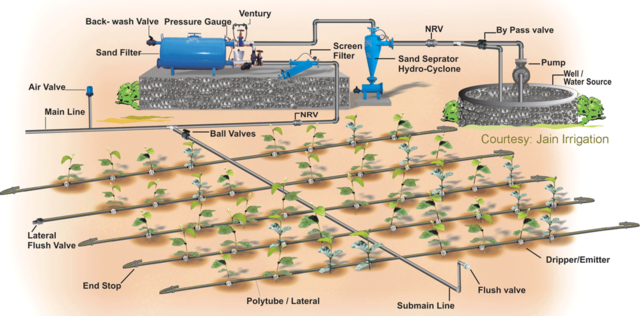Drip irrigation system fertilization, on the one hand, because the soluble fertilizer is directly applied to the root zone of the crop with water, there is no waste of fertilizer on the open space between the crops. On the other hand, drip irrigation seeps into the root zone in the form of drip with small flow, which is very easy to control. There will be no deep washing waste of water and fertilizer. Nitrogen application by drip irrigation can achieve a fertilizer efficiency of 74%, while traditional application does not exceed 30%.
The disadvantage of using drip irrigation systems to fertilize is the possibility of clogging the dripper. Therefore, the selected fertilizer must be soluble, insoluble fertilizer will quickly block the dripper. The chemical reaction between fertilizer raw materials will also produce precipitation. Over time, the sediment will block the drip irrigation system.
1. Solubility of chemical fertilizers and precautions
To apply fertilizer by drip irrigation system, the solubility of fertilizer must be carefully studied. Fertilizers that are insoluble, of low solubility, or that easily react to form precipitates under certain conditions should be avoided.
For most solid fertilizer coatings, in order to avoid the coating from clogging the drip irrigation system, it is best to select a small amount of sample into the dissolution tank and stir, and then observe the dissolution of the coating. If the coating material settles to the bottom of the tank after dissolving, let the fertilizer inject the upper layer solution during application, and do not agitate the whole fertilizer solution.
2. Nitrogen application in drip irrigation system
Nitrogen fertilizer is the most applied fertilizer using drip irrigation system. Nitrogen fertilizers generally have good water solubility and are easily applied to the root zone of crops as irrigation water drops into the soil. But if not controlled properly, it is also easy to produce leaching losses. Due to the small drip irrigation flow rate (single dripper: 4 to 8 liters/hour), it is very easy to control the rinse head. If both irrigation and fertilization are automatically controlled, rinsing of damaged heads can be avoided completely.
Among all nitrogen fertilizers, urea and ammonium nitrate are most suitable for drip irrigation. Because the risk of clogging with these two fertilizers is minimal, ammonia is generally not recommended for drip irrigation, because ammonia will increase the pH of the water. The increase in pH will cause calcium, magnesium, and phosphorus to settle in the irrigation water, clogging the dripper. Ammonium sulfate and calcium nitrate are water soluble, but there is also a risk of clogging.
3. Phosphorus application in drip irrigation system
Phosphorus is not as active in soil as nitrogen. Generally, the volatilization loss of phosphorus is less than that of nitrogen. Most crops require phosphorus early in growth. Therefore, phosphate fertilizer should be applied before or during planting. If signs of phosphorus deficiency are found at the production stage, injecting phosphate fertilizer into the irrigation water can also supplement the deficiency of phosphorus.
Injecting phosphate fertilizer may block the drip irrigation system. Due to the reaction of water and phosphate fertilizer, solid precipitation often occurs in the water, causing blockage. Calcium superphosphate, agricultural monoammonium phosphate, agricultural diammonium phosphate and other solid phosphate fertilizers cannot be injected into the irrigation system due to their low solubility. The industrial grade monoammonium phosphate, diammonium phosphate, potassium dihydrogen phosphate, polyphosphate and other phosphate fertilizers are soluble and can generally be used for drip irrigation.

